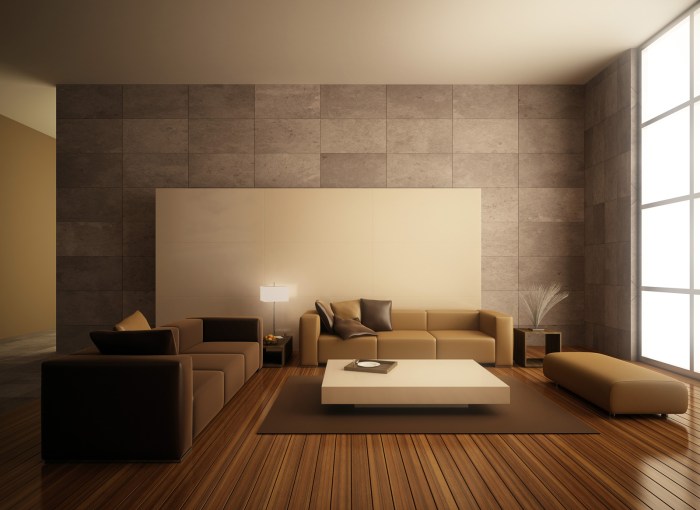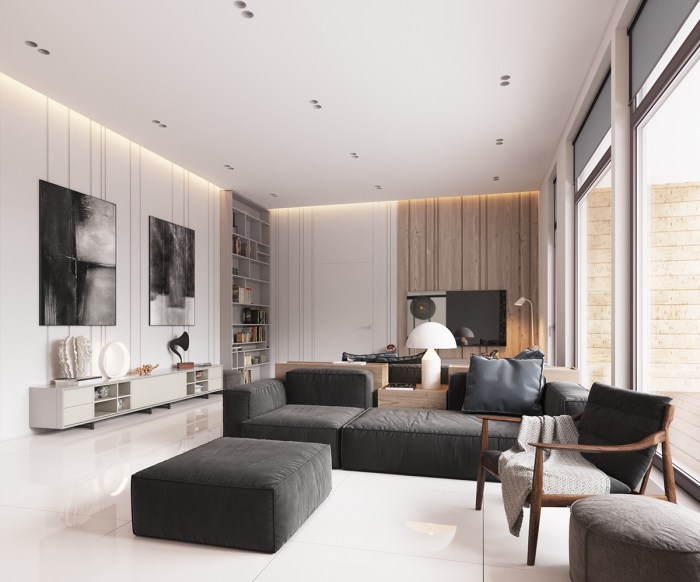Exploring Minimalist Interior Design: A Guide to Simplifying Your Space
Embark on a journey into the world of minimalist interior design, where less is truly more. Discover the art of creating serene and clutter-free spaces that exude elegance and simplicity.
Delve into the key principles and elements that define minimalist design, and learn how to transform your living spaces into havens of tranquility and style.
Understanding Minimalist Interior Design

Minimalist interior design is a style that focuses on simplicity, functionality, and elegance. It is characterized by clean lines, neutral colors, and a clutter-free environment. The philosophy behind minimalist design is to create a space that is calming, uncluttered, and allows for better focus and relaxation.
Key Characteristics of Minimalist Design
Minimalist interior design is defined by the following key characteristics:
- Simple color palette: Minimalist spaces often use a neutral color palette, such as whites, grays, and blacks, to create a sense of calm and serenity.
- Clean lines: Furniture and decor in minimalist design have clean, straight lines with no ornate details or embellishments.
- Functional furniture: Every piece of furniture in a minimalist space serves a purpose and is chosen for its functionality rather than its aesthetics.
- Clutter-free environment: Minimalist design emphasizes the importance of decluttering and keeping only essential items in the space.
- Focus on space and light: Minimalist interiors make use of ample space and natural light to create an open and airy feel.
Philosophy Behind Minimalism in Interior Design
In interior design, minimalism is not just about aesthetics but also about creating a lifestyle that is focused on what truly matters. By eliminating excess and unnecessary items, minimalist design promotes a sense of mindfulness, simplicity, and intentionality in the way we live.
It encourages us to prioritize quality over quantity and to appreciate the beauty of simplicity in our surroundings.
Elements of Minimalist Interior Design
In minimalist interior design, less is more. This style focuses on simplicity, clean lines, and a clutter-free environment to create a sense of calm and tranquility in a space.
Essential Elements in a Minimalist Space
- Simplicity: Minimalist spaces are characterized by a simple and uncluttered layout, with only essential furniture and decor items.
- Clean Lines: Straight lines and geometric shapes are commonly used in minimalist design to create a sense of order and harmony.
- Neutral Colors: Minimalist spaces often feature a neutral color palette, such as white, beige, or gray, to create a clean and cohesive look.
- Functional Furniture: Furniture in a minimalist space is chosen for its functionality and practicality, with no unnecessary embellishments.
Role of Color in Minimalist Design
Color plays a crucial role in minimalist interior design. Neutral colors are typically used to create a sense of calm and serenity in a space. White is a popular choice for walls and furniture, as it helps to reflect light and make a room feel more spacious.
However, pops of color can also be incorporated through accessories or artwork to add visual interest without overwhelming the space.
Importance of Lighting in Creating a Minimalist Interior
Lighting is essential in minimalist design to enhance the overall ambiance of a space. Natural light is preferred in minimalist interiors to create a bright and airy environment. Additionally, the use of strategic artificial lighting, such as recessed lights or pendant lamps, can help highlight key architectural features and create a warm and inviting atmosphere.
Furniture and Decor in Minimalist Design

When it comes to minimalist interior design, furniture and decor play a crucial role in achieving a clean and clutter-free space. Selecting the right pieces and keeping the decor simple yet impactful are key elements of this design aesthetic.
Type of Furniture Suitable for Minimalist Interiors
- Choose furniture with clean lines and simple silhouettes to maintain a minimalist look.
- Opt for pieces with neutral colors like white, beige, or grey to create a sense of calm and spaciousness.
- Invest in multifunctional furniture to maximize space and reduce clutter in a minimalist setting.
Selecting Decor Items in Line with Minimalist Principles
- Stick to a color palette of muted tones and incorporate pops of color sparingly to add visual interest.
- Avoid excessive accessorizing and opt for a few statement pieces that complement the overall design.
- Choose decor items with simple geometric shapes or natural textures to enhance the minimalist aesthetic.
Tips for Decluttering and Organizing in a Minimalist Space
- Regularly declutter by getting rid of items that are not essential or do not serve a purpose in your space.
- Utilize storage solutions like hidden cabinets or built-in shelves to keep everyday items out of sight.
- Embrace a "less is more" approach when organizing, focusing on quality over quantity to maintain a clean and streamlined look.
Maximizing Space in Minimalist Design
When it comes to minimalist design, maximizing space is essential to maintain the clean and uncluttered look. Here are some techniques to help you make the most of your space while staying true to minimalist principles.
Utilize Multi-functional Furniture
One way to maximize space in a minimalist setting is to choose furniture pieces that serve multiple purposes. For example, a sofa bed can provide seating during the day and transform into a bed for guests at night. This helps reduce the need for extra furniture and opens up more floor space.
Opt for Built-in Storage Solutions
Incorporating built-in storage solutions is a great way to keep belongings out of sight while maintaining a minimalist aesthetic. Consider wall-mounted shelves, hidden cabinets, or under-bed storage to maximize space without adding visual clutter.
Embrace Minimalist Decor Elements
To create a sense of openness and airiness in a minimalist space, opt for decor elements that are simple and streamlined. Choose neutral colors, clean lines, and minimalistic accessories to keep the space feeling light and unobtrusive.
Keep Surfaces Clear
In a minimalist design, it's important to keep surfaces clear of unnecessary items. Avoid overcrowding countertops, tables, and floors with knick-knacks or decor pieces. Instead, opt for a few carefully curated items that add to the overall aesthetic without overwhelming the space.
Use Mirrors to Create Illusion of Space
Strategically placing mirrors in a minimalist space can help create the illusion of a larger room. Mirrors reflect light and make the space feel more open and airy. Consider incorporating a large mirror on a wall or placing smaller mirrors strategically to maximize the sense of space.
Minimalist Design in Different Rooms
When it comes to applying minimalist design principles in different rooms of the house, each space presents its own unique set of challenges and benefits. Let's explore how minimalism can be implemented in various living spaces.
Living Room
In the living room, minimalist design can create a sense of openness and tranquility. To achieve this, focus on decluttering the space and incorporating simple, functional furniture pieces. Opt for a neutral color palette and limit the number of decorative items to maintain a clean and streamlined look.
- Choose a sleek sofa with clean lines and minimal embellishments.
- Use storage solutions such as hidden cabinets or multi-functional furniture to keep the space organized.
- Incorporate a few carefully selected art pieces or decorative accents to add personality without overwhelming the space.
Bedroom
Minimalist design in the bedroom can promote relaxation and restful sleep. Keep the focus on creating a calming environment with minimal distractions. Opt for a simple bed frame, uncluttered surfaces, and soft, soothing colors.
- Invest in a quality mattress and bedding for comfort and durability.
- Use built-in storage solutions or minimalist wardrobes to keep clothing and personal items out of sight.
- Limit the use of electronics and decorative items to create a peaceful atmosphere conducive to sleep.
Kitchen
In the kitchen, minimalist design can enhance functionality and efficiency. Focus on clean lines, ample storage, and a clutter-free workspace. Choose sleek appliances and durable materials for a modern and practical look.
- Opt for integrated appliances to maintain a seamless and uncluttered appearance.
- Maximize storage with well-organized cabinets and drawers to keep essentials within reach.
- Keep countertops clear of unnecessary items to create a clean and efficient cooking area.
Last Recap
In conclusion, minimalist interior design offers a refreshing approach to decorating your home, focusing on functionality, clean lines, and a sense of calm. Embrace the beauty of simplicity and create a harmonious environment that speaks volumes with very few words.
FAQ Guide
What is minimalist interior design?
Minimalist interior design is a style characterized by simplicity, clean lines, and a focus on functionality. It involves decluttering spaces and creating a sense of calm and openness.
How do you select decor items for a minimalist space?
Choose decor items that are simple, functional, and have a purpose. Opt for neutral colors, clean designs, and avoid excessive ornamentation.
What are some techniques for maximizing space in a minimalist setting?
Use multi-functional furniture, utilize vertical storage solutions, and keep surfaces clutter-free to make the most of the space in a minimalist design.




